|
THE SUDDEN
CIVILIZATION
FOR A LONG TIME, Western man believed that his civilization was the
gift of Rome and Greece. But the Greek philosophers themselves wrote
repeatedly that they had drawn on even earlier sources. Later on,
travelers returning to Europe reported the existence in Egypt of
imposing pyramids and temple-cities half-buried in the sands,
guarded by strange stone beasts called sphinxes.
When Napoleon arrived in Egypt in 1799, he took with him scholars to
study and explain these ancient monuments. One of his officers found
near Rosetta a stone slab on which was carved a proclamation from
196 B.C. written in the ancient Egyptian pictographic writing
(hieroglyphic) as well as in two other scripts.
The decipherment of the ancient Egyptian script and language, and
the archaeological efforts that followed, revealed to Western man
that a high civilization had existed in Egypt well before the advent
of the Greek civilization. Egyptian records spoke of royal dynasties
that began circa 3100 B.C. - two full millennia before the beginning
of Hellenic civilization. Reaching its maturity in the fifth and
fourth centuries B.C., Greece was a latecomer rather than an
originator.
Was the origin of our civilization, then, in Egypt?
As logical as
that conclusion would have seemed, the facts militated against it.
Greek scholars did describe visits to Egypt, but the ancient sources
of knowledge of which they spoke were found elsewhere. The
pre-Hellenic cultures of the Aegean Sea - the Minoan on the island
of Crete and the Mycenaean on the Greek mainland - revealed evidence
that the Near Eastern, not the Egyptian, culture had been adopted.
Syria and Anatolia, not Egypt, were the principal avenues through
which an earlier civilization became available to the Greeks.
Noting that the Dorian invasion of Greece and the Israelite invasion
of Canaan following the Exodus from Egypt took place at about the
same time (circa the thirteenth century B.C.), scholars have been
fascinated to discover a growing number of similarities between the
Semitic and Hellenic civilizations.
Professor Cyrus H. Gordon
(Forgotten Scripts; Evidence for the Minoan Language) opened up a
new field of study by showing that an early Minoan script, called
Linear A, represented a Semitic language.
He concluded that "the
pattern (as distinct from the content) of the Hebrew and Minoan
civilizations is the same to a remarkable extent," and pointed out
that the island's name, Crete, spelled in Minoan Ke-re-ta, was the
same as the Hebrew word Ke-re-et ("walled city") and had a
counterpart in a Semitic tale of a king of Keret.
Even the Hellenic alphabet, from which the Latin and our own
alphabets derive, came from the Near East. The ancient Greek
historians themselves wrote that a Phoenician named Kadmus
("ancient") brought them the alphabet, comprising the same number of
letters, in the same order, as in Hebrew; it was the only Greek
alphabet when the Trojan War took place. The number of letters was
raised to twenty-six by the poet Simonides of Ceos in the fifth
century B.C.
That Greek and Latin writing, and thus the whole foundation of our
Western culture, were adopted from the Near East can easily be
demonstrated by comparing the order, names, signs, and even
numerical values of the original Near Eastern alphabet with the much
later ancient Greek and the more recent Latin.
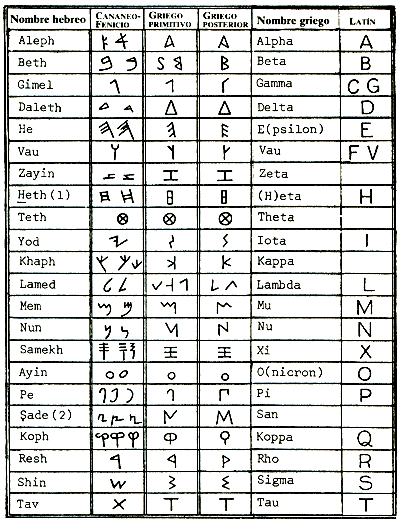
The scholars were aware, of course, of Greek contacts with the Near
East in the first millennium B.C., culminating with the defeat of
the Persians by Alexander the Macedonian in 331 B.C.
Greek records
contained much information about these Persians and their lands
(which roughly paralleled today's Iran). Judging by the names of
their kings - Cyrus, Darius, Xerxes - and the names of their
deities, which appear to belong to the Indo-European linguistic
stem, scholars reached the conclusion that they were part of the
Aryan ("lordly") people that appeared from somewhere near the
Caspian Sea toward the end of the second millennium B.C. and spread
westward to Asia Minor, eastward to India, and southward to what the
Old Testament called the "lands of the Medes and Parsees."
Yet all was not that simple. In spite of the assumed foreign origin
of these invaders, the Old Testament treated them as part and parcel
of biblical events. Cyrus, for example, was considered to be an
"Anointed of
Yahweh" - quite an unusual relationship between the
Hebrew God and a non-Hebrew.
According to the biblical Book of Ezra,
Cyrus acknowledged his mission to rebuild the Temple in Jerusalem,
and stated that he was acting upon orders given by Yahweh, whom he
called "God of Heaven." Cyrus and the other kings of his dynasty
called themselves Achaemenids - after the title adopted by the
founder of the dynasty, which was Hacham-Anish.
It was not an Aryan
but a perfect Semitic title, which meant "wise man."
By and large,
scholars have neglected to investigate the many leads that may point
to similarities between the Hebrew God Yahweh and the deity Achaemenids called "Wise Lord," whom they depicted as hovering in
the skies within a Winged Globe, as shown on the royal seal of
Darius.
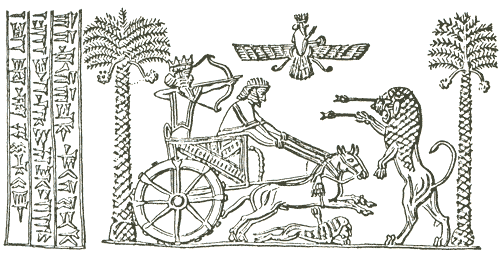
It has been established by now that the cultural, religious, and
historic roots of these Old Persians go back to the earlier empires
of Babylon and Assyria, whose extent and fall is recorded in the Old
Testament.
The symbols that make up the script that appeared on the Achaemenid monuments and seals were at first considered to be
decorative designs. Engelbert Kampfer, who visited Persepolis, the
Old Persian capital, in 1686, described the signs as "cuneates," or
wedge-shaped impressions. The script has since been known as
cuneiform.
As efforts began to decipher the Achaemenid inscriptions, it became
clear that they were written in the same script as inscriptions
found on ancient artifacts and tablets in Mesopotamia, the plains
and highlands that lay between the Tigris and Euphrates rivers.
Intrigued by the scattered finds, Paul Emile Botta set out in 1843
to conduct the first major purposeful excavation.
He selected a site
in northern Mesopotamia, near present-day Mosul, now called Khorsabad. Botta was soon able to establish that the cuneiform
inscriptions named the place Dur Sharru Kin. They were Semitic
inscriptions, in a sister language of Hebrew, and the name meant
"walled city of the righteous king." Our textbooks call this king
Sargon II.
This capital of the Assyrian king had as its center a magnificent
royal palace whose walls were lined with sculptured bas-reliefs,
which, if placed end to end, would stretch for over a mile.
Commanding the city and the royal compound was a step pyramid called
a ziggurat; it served as a "stairway to Heaven" for the gods.
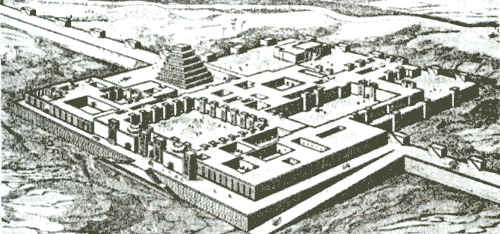
The layout of the city and the sculptures depicted a way of life on
a grand scale.
The palaces, temples, houses, stables, warehouses,
walls, gates, columns, decorations, statues, artworks, towers,
ramparts, terraces, gardens - all were completed in just five years.
According to Georges Contenau (La Vie Quotidienne a Babylone et en
Assyrie), "the imagination reels before the potential strength of an
empire which could accomplish so much in such a short space of
time," some 3,000 years ago.
Not to be outdone by the French, the English appeared on the scene
in the person of Sir Austen Henry Layard, who selected as his site a
place some ten miles down the Tigris River from Khorsabad. The
natives called it Kuyunjik; it turned out to be the Assyrian capital
of Nineveh.
Biblical names and events had begun to come to life. Nineveh was the
royal capital of Assyria under its last three great rulers:
Sennacherib, Esarhaddon, and Ashurhanipal.
"Now, in the fourteenth
year of king Hezekiah, did Sennacherib king of Assyria come up
against all the walled cities of Judah," relates the Old Testament
(II Kings 18:13), and when the Angel of the Lord smote his army, "Sennacherib departed and went back, and dwelt in Nineveh."
The mounds where Nineveh was built by Sennacherib and Ashurbanipal
revealed palaces, temples, and works of art that surpassed those of
Sargon.
The area where the remains of Esarhaddon's palaces are
believed to lie cannot be excavated, for it is now the site of a
Muslim mosque erected over the purported burial place of the prophet
Jonah, who was swallowed by a whale when he refused ID bring
Yahweh's message to Nineveh.
Layard had read in ancient Greek records that an officer in
Alexander's army saw a "place of pyramids and remains of an ancient
city" - a city that was already buried in Alexander's time! Layard
dug it up, too, and it turned out to be Nimrud, Assyria's military
center. It was there that Shalmaneser II set up an obelisk to record
his military expeditions and conquests. Now on exhibit at the
British Museum, the obelisk lists, among the kings who were made to
pay tribute, "Jehu, son of Omri, king of Israel."
Again, the Mesopotamian inscriptions and biblical texts supported
each other!
Astounded by increasingly frequent corroboration of the biblical
narratives by archaeological finds, the Assyriologists, as these
scholars came to be called, turned to the tenth chapter of the Book
of Genesis. There Nimrod - "a mighty hunter by the grace of Yahweh"
- was des6ribed as the founder of all the kingdoms of Mesopotamia.
And the beginning of his kingdom:
Babel and Erech and Akkad, all in the Land of Shin'ar.
Out of that Land there emanated Ashur where
Nineveh was built, a city of wide streets; and Khalah, and Ressen -
the great city
which is between Nineveh and Khalah.
There were indeed mounds the natives called Calah, lying between
Nineveh and Nimrud.
When teams under W. Andrae excavated the area
from 1903 to 1914, they uncovered the ruins of Ashur, the Assyrian
religious center and its earliest capital. Of all the Assyrian
cities mentioned in the Bible, only Ressen remains to be found. The
name means "horse's bridle"; perhaps it was the location of the
royal stables of Assyria.
At about the same time as Ashur was being excavated, teams under R. Koldewey were completing the excavation of Babylon, the biblical
Babel - a vast place of palaces, temples, hanging gardens, and the
inevitable ziggurat. Before long, artifacts and inscriptions
unveiled the history of the two competing empires of Mesopotamia:
Babylonia and Assyria, the one centered in the south, the other in
the north.
Rising and falling, fighting and coexisting, the two constituted a
high civilization that encompassed some 1,500 years, both rising
circa 1900 B.C.
Ashur and Nineveh were finally captured and
destroyed by the Babylonians in 614 and 612 B.C., respectively. As
predicted by the biblical prophets, Babylon itself came to an
inglorious end when Cyrus the Achaemenid conquered it in 539 B.C.
Though they were rivals throughout their history, one would be hard
put to find any significant differences between Assyria and
Babylonia in cultural or material matters. Even though Assyria
called its chief deity Ashur ("all-seeing") and Babylonia hailed
Marduk ("son of the pure mound"), the pantheons were otherwise
virtually alike.
Many of the world's museums count among their prize exhibits the
ceremonial gates, winged bulls, bas-reliefs, chariots, tools,
utensils, jewelry, statues, and other objects made of every
conceivable material that have been dug out of the mounds of Assyria
and Babylonia.
But the true treasures of these kingdoms were their
written records:
thousands upon thousands of inscriptions in the
cuneiform script, including cosmologic tales, epic poems, histories
of kings, temple records, commercial contracts, marriage and divorce
records, astronomical tables, astrological forecasts, mathematical
formulas, geographic lists, grammar and vocabulary school texts,
and, not least of all, texts dealing with the names, genealogies,
epithets, deeds, powers, and duties of the gods.
The common language that formed the cultural, historical, and
religious bond between Assyria and Babylonia was Akkadian. It was
the first known Semitic language, akin to but predating Hebrew,
Aramaic, Phoenician, and Canaanite. But the Assyrians and
Babylonians laid no claim to having invented the language or its
script; indeed, many of their tablets bore the postscript that they
had been copied from earlier originals.
Who, then, invented the cuneiform script and developed the language,
its precise grammar and rich vocabulary? Who wrote the "earlier
originals"? And why did the Assyrians and Babylonians call the
language Akkadian?
Attention once more focuses on the Book of Genesis. And the
beginning of his kingdom: Babel and Erech and Akkad." Akkad - could
there really have been such a royal capital, preceding Babylon and
Nineveh?
The ruins of Mesopotamia have provided conclusive evidence that once
upon a time there indeed existed a kingdom by the name of Akkad,
established by a much earlier ruler, who called himself a sharrukin
("righteous ruler"). He claimed in his inscriptions that his empire
stretched, by the grace of his god Enlil, from the Lower Sea (the
Persian Gulf) .to the Upper Sea (believed to be the Mediterranean).
He boasted that "at the wharf of Akkad, he made moor ships" from
many distant lands.
The scholars stood awed: They had come upon a Mesopotamian empire in
the third millennium B.C.! There was a leap - backward - of some
2,000 years from the Assyrian Sargon of Dur Sharrukin to Sargon of
Akkad. And yet the mounds that were dug up brought to light
literature and art, science and politics, commerce and
communications - a full-fledged civilization - long before the
appearance of Babylonia and Assyria. Moreover, it was obviously the
predecessor and the source of the later: Mesopotamian
civilizations; Assyria and Babylonia were only branches off the Akkadian trunk.
The mystery of such an early Mesopotamian civilization deepened,
however, as inscriptions recording the achievements and genealogy of
Sargon of Akkad were found. They stated that his full title was
"King of Akkad, King of Kish"; they explained that before he assumed
the throne, he had been a counselor to the "rulers of Kish." Was
there, then - the scholars asked themselves- - an even earlier
kingdom, that of Kish, which preceded Akkad?
Once again, the
biblical verses gained in significance.
And Kush begot Nimrod;
He was first to be a Hero in the Land....
And the beginning of his kingdom:
Babel and Erech and Akkad.
Many scholars have speculated that Sargon of Akkad was the biblical
Nimrod.
If one reads "Kish" for "Kush" in the above biblical verses,
it would seem Nimrod was indeed preceded by Kish, as claimed by
Sargon. The scholars then began to accept literally the rest of his
inscriptions:
"He defeated Uruk and tore down its wall ... he was
victorious in the battle with the inhabitants of Ur... he
defeated the entire territory from Lagash as far as the sea."
Was the biblical Erech identical with the Uruk of Sargon's
inscriptions? As the site now called Warka was unearthed, that was
found to be the case. And the Ur referred to by Sargon was none
other than the biblical Ur, the Mesopotamian birthplace of Abraham.
Not only did the archaeological discoveries vindicate the biblical
records; it also appeared certain that there must have been kingdoms
and cities and civilizations in Mesopotamia even before the third
millennium B.C. The only question was: How far back did one have to
go to find the first civilized kingdom?
The key that unlocked the puzzle was yet another language.
Scholars quickly realized that names had a meaning not only in
Hebrew and in the Old Testament but throughout the ancient Near
East. All the Akkadian, Babylonian, and Assyrian names of persons
and places had a meaning. But the names of rulers that preceded
Sargon of Akkad did not make sense at all: The king at whose court
Sargon was a counselor was called Urzababa; the king who reigned in
Erech was named Lugalzagesi; and so on.
Lecturing before the Royal Asiatic Society in 1853, Sir Henry
Rawlinson pointed out that such names were neither Semitic nor
Indo-European; indeed,
"they seemed to belong to no known group of
languages or peoples."
But if names had a meaning, what was the
mysterious language in which they had the meaning?
Scholars took another look at the Akkadian inscriptions. Basically,
the Akkadian cuneiform script was syllabic: Each sign stood for a
complete syllable (ab, ba, bat, etc.).
Yet the script made extensive
use of signs that were not phonetic syllables but conveyed the
meanings "god," "city," "country," or "life," "exalted," and the
like. The only possible explanation for this phenomenon was that
these signs were remains of an earlier writing method which used
pictographs. Akkadian, then, must have been preceded by another
language that used a writing method akin to the Egyptian
hieroglyphs.
It was soon obvious that an earlier language, and not lust an
earlier form of writing, was involved here. Scholars
found that Akkadian inscriptions and texts made extensive use of
loanwords - words borrowed intact from another language (in the same
way that a modern Frenchman would borrow the English word weekend).
This was especially true where scientific or technical terminology
was involved, and also in matters dealing with the gods and the
heavens.
One of the greatest finds of Akkadian texts was the ruins of a
library assembled in Nineveh by Ashurbanipal; Layard and his
colleagues carted away from the site 25,000 tablets, many of which
were described by the ancient scribes as copies of "olden texts." A
group of twenty-three tablets ended with the statement: "23rd
tablet: language of Shumer not changed."
Another text bore an
enigmatic statement by Ashurbanipal himself:
The god of scribes has bestowed on me the gift of the knowledge of
his art.
I have been initiated into the secrets of writing.
I can even read the intricate tablets in Shumerian;
I understand the enigmatic words in the stone carvings from the days
before the Flood.
The claim by Ashurbanipal that he could read intricate tablets in "Shumerian"
and understand the words written on tablets from "the days before
the Flood" only increased the mystery.
But in January 1869 Jules Oppert suggested to the French Society of Numismatics and
Archaeology that recognition be given to the existence of a pre-Akkadian
language and people. Pointing out that the early rulers of
Mesopotamia proclaimed their legitimacy by taking the title "King of
Sumer and Akkad," he suggested that the people be called
"Sumerians," and their land, "Sumer."
Except for mispronouncing the name - it should have been Shumer, not
Sumer - Oppert was right. Sumer was not a mysterious, distant land,
but the early name for southern Mesopotamia, just as the Book of
Genesis had clearly stated: The royal cities of Babylon and Akkad
and Erech were in "the Land of Shin'ar." (Shinar was the biblical
name for Shumer.)
Once the scholars had accepted these conclusions, the flood gates
were opened. The Akkadian references to the • "olden texts" became
meaningful, and scholars soon realized that tablets with long
columns of words were in fact Akkadian-Sumerian lexicons and
dictionaries, prepared in Assyria and Babylonia for their own study
of the first written language, Sumerian.
Without these dictionaries from long ago, we would still be far from
being able to read Sumerian.
With their aid, a vast literary and
cultural treasure opened up. It also became clear that the Sumerian
script, originally pictographic and carved in stone in vertical
columns, was then turned horizontally and, later on, stylized for
wedge writing on soft clay tablets to become the cuneiform writing
that was adopted by the Akkadians, Babylonians, Assyrians, and other
nations of the ancient Near East.
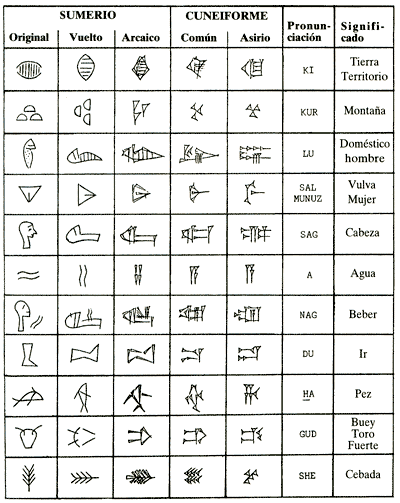
The decipherment of the Sumerian language and script, and the
realization that the Sumerians and their culture were the
fountainhead of the Akkadian - Babylonian-Assyrian achievements,
spurred archaeological searches in southern Mesopotamia.
All the
evidence now indicated that the beginning was there.
The first significant excavation of a Sumerian site was begun in
1877 by French archaeologists; and the finds from this single site
were so extensive that others continued to dig there until 1933
without completing the job.
Called by the natives Telloh ("mound"), the site proved to be an
early Sumerian city, the very Lagash of whose conquest Sargon of
Akkad had boasted. It was indeed a royal city whose rulers bore the
same title Sargon had adopted, except that it was in the Sumerian
language: EN.SI ("righteous ruler"). Their dynasty had started circa
2900 B.C. and lasted for nearly 650 years. During this time,
forty-three ensi’s reigned without interruption in Lagash: Their
names, genealogies, and lengths of rule were all neatly recorded.
The inscriptions provided much information. Appeals to the gods "to
cause the grain sprouts to grow for harvest ... to cause the watered
plant to yield grain," attest to the existence of agriculture and
irrigation.
A cup inscribed in honor of a goddess by "the overseer
of the granary" indicated that grains were stored, measured, and
traded.
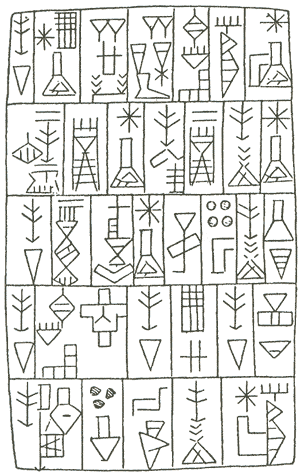
An ensi named Eannatum left an inscription on a clay brick which
makes it clear that these Sumerian rulers could assume the throne
only with the approval of the gods. He also recorded the conquest of
another city, revealing to us the existence of other city-states in
Sumer at the beginning of the-third millennium B.C.
Eannatum's successor, Entemena, wrote of building a temple and
adorning it with gold and silver, planting gardens, enlarging
brick-lined wells. He boasted of building a fortress with
watchtowers and facilities for docking ships.
One of the better-known rulers of Lagash was Gudea. He had a large
number of statuettes made of himself, all showing him in a votive
stance, praying to his gods. This stance was no pretense: Gudea had
indeed devoted himself to the adoration of Ningirsu, his principal
deity, and to the construction and rebuilding of temples.
His many inscriptions reveal that, in the search for exquisite
building materials, he obtained gold from Africa and Anatolia,
silver from the Taurus Mountains, cedars from Lebanon, other rare
woods from Ararat, copper from the Zagros range, diorite from Egypt,
carnelian from Ethiopia, and other materials from lands as yet
unidentified by scholars.
When Moses built for the Lord God a "Residence" in the desert, he
did so according to very detailed instructions provided by the Lord.
When King Solomon built the first Temple in Jerusalem, he did so
after the Lord had "given him wisdom."
The prophet Ezekiel was shown
very detailed plans for the Second Temple,
"in a Godly vision" by a
"person who had the appearance of bronze and who Held in his hand a
flaxen string and a measuring rod."
Ur-Nammu, ruler of Ur, depicted
in an earlier millennium how his god, ordering him to build for him
a temple and giving him the pertinent instructions, handed him the
measuring rod and rolled string for the job.
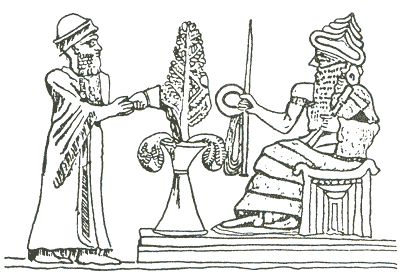
Twelve hundred years before Moses, Gudea made the ,same claim.
The
instructions, he recorded in one very long inscription, were given
to him in a vision. "A man that shone like the heaven," by whose
side stood "a divine bird," "commanded me to build his temple." This
"man," who "from the crown on his head was obviously a god," was
later identified as the god Ningirsu.
With him was a goddess who
"held the tablet of her favorable star of the heavens"; her other
hand "held a holy stylus," with which she indicated to Gudea "the
favorable planet." A third man, also a god, held in his hand a
tablet of precious stone; "the plan of a temple it contained."
One
of Gudea's statues shows him seated, with this tablet on his knees;
on the tablet the divine drawing can clearly be seen.
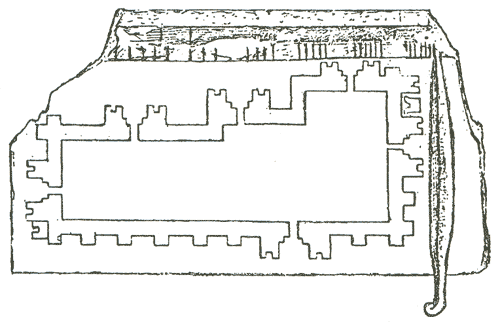
Wise as he was, Gudea was baffled by these architectural
instructions, and he sought the advice of a goddess who could
interpret divine messages.
She explained to him the meaning of the
instructions, the plan's measurements, and the size and shape of the
bricks to be used. Gudea then employed a male "diviner, maker of
decisions" and a female "searcher of secrets" to locate the site, on
the city's outskirts, where the god wished his temple to be built.
He then recruited 216,000 people for the construction job.
Gudea's bafflement can readily be understood, for the simple-looking
"floor plan" supposedly gave him the necessary information to build
a complex ziggurat, rising high by seven stages. Writing in Der Alte
Orient in 1900, A-Billerbeck was able to decipher at least part of
the divine architectural instructions.
The ancient drawing, even on the partly
damaged statue, is accompanied at the top by groups of vertical
lines whose number diminishes as the space between them increases.
The divine architects, it appears, were able to provide, with a
single floor plan, accompanied by seven varying scales, the complete
instructions for the construction of a seven-stage
high-rise temple.
It has been said that 'war spurs Man to scientific and material
breakthroughs. In ancient Sumer, it seems, temple construction
spurred the people and their rulers into greater technological
achievements.
The ability to carry out major construction work
according to prepared architectural plans, to organize and feed a
huge labor force, to flatten land and raise mounds, to mold bricks
and transport stones, to bring rare metals and other materials from
afar, to east metal and shape utensils and ornaments - all clearly
speak of a high civilization, already in full bloom in the third
millennium B.C.
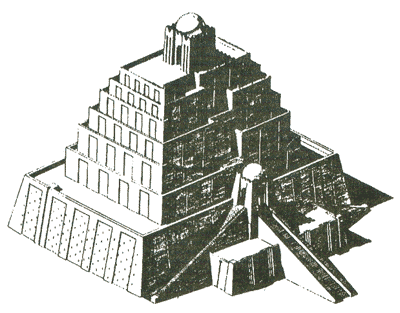
As masterful as even the earliest Sumerian temples were, they
represented but the tip of the iceberg of the scope and richness of
the material achievements of the first great civilization known to
Man.
In addition to the invention and development of writing, without
which a high civilization could not have come about, the Sumerians
should also be credited with the invention of printing. Millennia
before Johann Gutenberg "invented" printing by using movable type,
Sumerian scribes used ready-made "type" of the various pictographic
signs, which they used as we now use rubber stamps to impress the
desired sequence of signs in the wet clay.
They also invented the forerunner of our rotary presses - the
cylinder seal. Made of extremely hard stone, it was a small cylinder
into which the message or design had been engraved in reverse;
whenever the seal was rolled on the wet clay, the imprint created a
"positive" impression on the clay.
The seal also enabled one to
assure the authenticity of documents; a new impression could be made
at once to compare it with the old impression on the document.
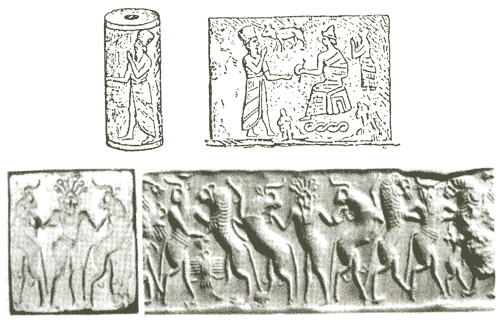
Many Sumerian and Mesopotamian written records concerned themselves
not necessarily with the divine or spiritual but with such daily
tasks as recording crops, measuring fields, and calculating prices.
Indeed, no high civilization would have been possible without a
parallel advanced system of mathematics.
The Sumerian system, called sexagesimal, combined a mundane 10 with
a "celestial" 6 to obtain the base figure 60. This system is in some
respects superior to our present one; in any case, it is
unquestionably superior to later Greek and Roman systems. It enabled
the Sumerians to divide into fractions and multiply into the
millions, to calculate roots or raise numbers several powers.
This
was not only the first-known mathematical system but also one that
gave us the "place" concept: Just as, in the decimal system, 2 can
be 2 or 20 or 200, depending on the digit's place, so could a
Sumerian 2 mean 2 or 120 (2 x 60), and so on, depending on the
"place."
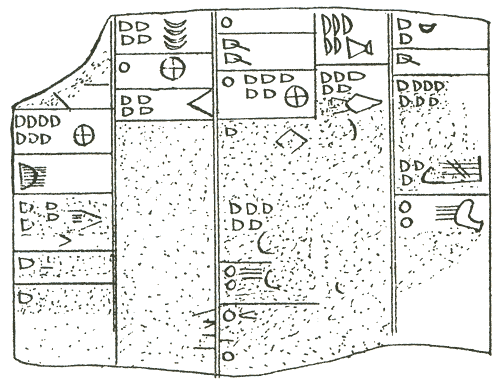
The 360-degree circle, the foot and its 12 inches, and the "dozen"
as a unit are but a few examples of the vestiges of Sumerian
mathematics still evident in our daily life.
Their concomitant
achievements in astronomy, the establishment of a calendar, and
similar mathematical-celestial feats will receive much closer study
in coming chapters.
Just as our own economic and social system - our books, court and
tax records, commercial contracts, marriage certificates, and so on
- depends on paper, Sumerian/ Mesopotamian life depended on clay.
Temples, courts, and trading houses had their scribes ready with
tablets of wet clay on which to inscribe decisions, agreements,
letters, or calculate prices, wages, the area of a field, or the
number of bricks required in a construction.
Clay was also a crucial raw material for the manufacture of utensils
for daily use and containers for storage and transportation of
goods. It was also used to make bricks - another Sumerian "first,"
which made possible the building of houses for the people, palaces
for the kings, and imposing temples for the gods.
The Sumerians are credited with two technological breakthroughs that
made it possible to combine lightness with tensile strength for all
clay products: reinforcing and firing. Modern architects have
discovered that reinforced concrete, an extremely strong building
material, can be created by pouring cement into molds containing
iron rods; long ago, the Sumerians gave their bricks great strength
by mixing the wet clay with chopped reeds or straw.
They also knew
that clay products could be given tensile strength and durability by
firing them in a kiln. The world's first high-rise buildings and
archways, as well as durable ceramic wares, were made possible by
these technological breakthroughs.
The invention of the kiln - a furnace in which intense but
controllable temperatures could be attained without the risk of
contaminating products with dust or ashes - made possible an even
greater technological advance: the Age of Metals.
It has been assumed that man discovered that he could hammer "soft
stones" - naturally occurring nuggets of gold as well as copper and
silver compounds - into useful or pleasing shapes, sometime about
6000 B.C. The first hammered-metal artifacts were found in the
highlands of the Zagros and Taurus mountains.
However, as R. J.
Forbes (The Birthplace of Old World Metallurgy) pointed out, "in the
ancient Near East, the supply of native copper was quickly
exhausted, and the miner had to turn to ores." This required the
knowledge and ability to find and extract the ores, crush them, then
smelt and refine them - processes that could not have been carried
out without kiln-type furnaces and a generally advanced technology.
The art of metallurgy soon encompassed the ability to alloy copper
with other metals, resulting in a castable, hard, but malleable
metal we call bronze. The Bronze Age,, our first metallurgical age,
was also a Mesopotamian contribution to modern civilization. Much of
ancient commerce was devoted to the metals trade; it also formed the
basis for the development in Mesopotamia of banking and the first
money - the silver shekel ("weighed ingot").
The many varieties of metals and alloys for which Sumerian and
Akkadian names have been found and the extensive technological
terminology attest to the high level of metallurgy in ancient
Mesopotamia. For a while this puzzled the scholars because Sumer, as
such, was devoid of metal ores, yet metallurgy most definitely began
there.
The answer is energy. Smelting, refining, and alloying, as well as
casting, could not be done without ample supplies of fuels to fire
the kilns, crucibles, and furnaces. Mesopotamia may have lacked
ores, but it had fuels in abundance. So the ores were brought to the
fuels, which explains many early inscriptions describing the
bringing of metal ores from afar.
The fuels that made Sumer technologically supreme were bitumens and
asphalts, petroleum products that naturally seeped up to the surface
in many places in Mesopotamia. R. J. Forbes (Bitumen and Petroleum
in Antiquity) shows that the surface deposits of Mesopotamia were
the ancient world's prime source of fuels from the earliest times to
the Roman era.
His conclusion is that the technological use of these
petroleum products began in Sumer circa 3500 B.C.; indeed, he shows
that the use and knowledge of the fuels and their properties were
greater in Sumerian times than in later civilizations.
So extensive was the Sumerian use of these petroleum products - not
only as fuel but also as road-building materials, for waterproofing,
caulking, painting, cementing, and molding - that when
archaeologists searched for ancient Ur they found it buried in a
mound that the local Arabs called "Mound of Bitumen." Forbes shows
that the Sumerian language had terms for every genus and variant of
the bituminous substances found in Mesopotamia.
Indeed, the names of
bituminous and petroleum materials in other languages - Akkadian,
Hebrew, Egyptian, Coptic, Greek, Latin, and Sanskrit - can clearly
be traced to the Sumerian origins; for example, the most common word
for petroleum - naphta - derives from napatu ("stones that flare
up").
The Sumerian use of petroleum products was also basic to an advanced
chemistry. We can judge the high level of Sumerian knowledge not
only by the variety of paints and pigments used and such processes
as glazing but also by the remarkable artificial production of
semiprecious stones, including a substitute for lapis lazuli.
Bitumens were also used in Sumerian medicine, another field where
the standards were impressively high. The hundreds of Akkadian texts
that have been found employ Sumerian medical terms and phrases
extensively, pointing to the Sumerian origin of all Mesopotamian
medicine.
The library of Ashurbanipal in Nineveh included a medical section.
The texts were divided into three groups - bultitu ("therapy"),
shipir bel imti ("surgery") and urti mashmashshe ("commands and
incantations"). Early law codes included sections dealing with fees
payable to surgeons for successful operations, and penalties to be
imposed on them in case of failure: A surgeon, using a lancet to
open a patient's temple, was to lose his hand if he accidentally
destroyed the patient's eye.
Some skeletons found in Mesopotamian graves bore unmistakable marks
of brain surgery. A partially broken medical text speaks of the
surgical removal of a "shadow covering a man's eye," probably a
cataract; another text mentions the use of a cutting instrument,
stating that "if the sickness has reached the inside of the bone,
you shall scrape and remove."
Sick persons in Sumerian times could choose between an A.ZU ("water
physician") and an IA.ZU ("oil physician"). A tablet excavated in
Ur, nearly 5,000 years old, names a medical practitioner as "Lulu,
the doctor." There were also veterinarians - known either as
"doctors of oxen" or as "doctors of asses."
A pair of surgical tongs is depicted on a very early cylinder seal,
found at Lagash, that belonged to "Urlugale-dina, the doctor." The
seal also shows the serpent on a tree - the symbol of medicine to
this day. An instrument that was used by midwives to cut the
umbilical cord was also frequently depicted.
Sumerian medical texts deal into diagnosis and prescriptions. They
leave no doubt that the Sumerian physician did not resort to magic
or sorcery. He recommended cleaning and washing; soaking in baths of
hot water and mineral solvents; application of vegetable
derivatives; rubbing with petroleum compounds.
Medicines were made from plant and mineral compounds and were mixed
with liquids or solvents appropriate to the method of application.
If taken by mouth, the powders were mixed into wine, beer, or honey;
if "poured through the rectum" - administered in an enema - they
were mixed with plant or vegetable oils. Alcohol, which plays such
an important role in surgical disinfection and as a base for many
medicines, reached our languages through the Arabic kohl, from the
Akkadian kuhlu.
Models of livers indicate that medicine was taught at medical
schools with the aid of clay models of human organs. Anatomy must
have been an advanced science, for temple rituals called for
elaborate dissections of sacrificial animals - only a step removed
from comparable knowledge of human anatomy.
Several depictions on cylinder seals or clay tablets show people
lying on some kind of surgical table, surrounded by teams of gods or
people. We know from epics and other heroic texts that the Sumerians
and their successors in Mesopotamia were concerned with matters of
life, sickness, and death. Men like Gilgamesh, a king of Erech,
sought the "Tree of Life" or some mineral (a "stone") that could
provide eternal youth.
There were also references to efforts to
resurrect the dead, especially if they happened to be gods:
Upon the corpse, hung from the pole,
they directed the Pulse and the Radiance;
Sixty times the Water of Life,
Sixty times the Food of Life,
they sprinkled upon it;
And Inanna arose.
Were some ultramodern methods, about which we can only speculate,
known and used in such revival attempts?
That radioactive materials
were known and used to treat certain ailments is certainly suggested
by a scene of medical treatment depicted on a cylinder seal dating
to the very beginning of Sumerian civilization.
It shows, without
question, a man lying on a special bed; his face is protected by a
mask, and he is being subjected to some kind of radiation.
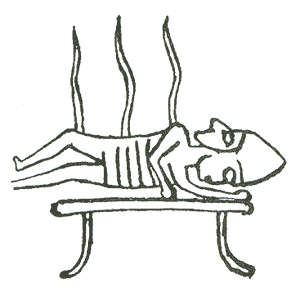
One of Sumer's earliest material achievements was the development of
textile and clothing industries.
Our own Industrial Revolution is considered to have commenced with
the introduction of spinning and weaving machines in England in the
1760s. Most developing nations have aspired ever since to develop a
textile industry as the first step toward industrialization. The
evidence shows that this has been the process not only since the
eighteenth century but ever since man's first great civilization.
Man could not have made woven fabrics before the advent of
agriculture, which provided him with flax, and the domestication of
animals, creating a source for wool. Grace M. Crowfoot (Textiles,
Basketry and Mats in Antiquity) ex-pressed the scholastic consensus
by stating that textile weaving appeared first in Mesopotamia,
around 3800 B.C.
Sumer, moreover, was renowned in ancient times not only for its
woven fabrics, but also for its apparel. The Book of Joshua (7:21)
reports that during the storming of Jericho a certain person could
not resist the temptation to keep "one good coat of Shin'ar," which
he had found in the city, even though the penalty was death. So
highly prized were the garments of Shinar (Sumer), that people were
willing to risk their lives to obtain them.
A rich terminology already existed in Sumerian times to describe
both items of clothing and their makers. The basic garment was
called TUG - without doubt, the forerunner in style as well as in
name of the Roman toga.
Such garments were TUG.TU.SHE, which in
Sumerian meant "garment which is worn wrapped around.”
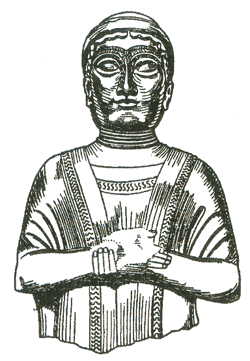
The ancient depictions reveal not only an astonishing variety and
opulence in matters of clothing, but also elegance, in which good
taste and coordination among clothes, hairdos, headdresses, and
jewelry prevailed.
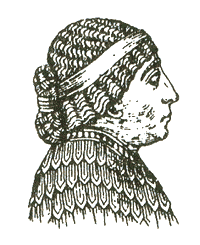 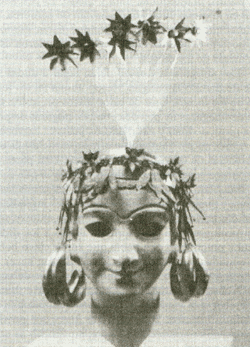
Another major Sumerian achievement was its agriculture. In a land
with only seasonal rains, the rivers were enlisted to water
year-round crops through a vast system of irrigation canals.
Mesopotamia - the Land Between the Rivers - was a veritable food
basket in ancient times.
The apricot tree, the Spanish word for
which is damasco ("Damascus tree"), bears the Latin name armeniaca,
a loanword from the Akkadian armanu. The cherry - kerasos in Greek,
Kirsche in German - originates from the Akkadian karshu. All the
evidence suggests that these and other fruits and vegetables reached
Europe from Mesopotamia.
So did many special seeds and spices: Our
word saffron comes from the Akkadian azupiranu, crocus from kurkanu
(via krokos in Greek), cumin from kamanu, hyssop from zupu, myrrh
from murru. The list is long; in many instances, Greece provided the
physical and etymological bridge by which these products of the land
reached Europe.
Onions, lentils, beans, cucumbers, cabbage, and
lettuce were common ingredients of the Sumerian diet.
What is equally impressive is the extent and variety of the ancient
Mesopotamian food-preparation methods, their cuisine. Texts and
pictures confirm the Sumerian knowledge of converting the cereals
they had grown into flour, from which they made a variety of
leavened and unleavened breads, porridges, pastries, cakes, and
biscuits.
Barley was also fermented to produce beer; "technical
manuals" for beer production have been found among the texts. Wine
was obtained from grapes and from date palms. Milk was available
from sheep, goats, and cows; it was used as a beverage, for cooking,
and for converting into yogurt, butter, cream, and cheeses. Fish was
a common part of the diet. Mutton was readily available, and the
meat of pigs, which the Sumerians tended in large herds, was
considered a true delicacy. Geese and ducks may have been reserved
for the gods' tables.
The ancient texts leave no doubt that the haute cuisine of ancient
Mesopotamia developed in the temples and in the service of the gods.
One text prescribed the offering to the gods of,
"loaves of barley
bread... loaves of emmer bread; a paste of honey and cream;
dates, pastry... beer, wine, milk... cedar sap, cream."
Roasted meat was offered with libations of "prime beer, wine, and
milk."
A specific cut of a bull was prepared according to a strict
recipe, calling for "fine flour... made to a dough in water,
prime beer, and wine," and mixed with animal fats, "aromatic
ingredients made from hearts of plants," nuts, malt, and spices.
Instructions for "the daily sacrifice to the gods of the city of Uruk" called for the serving of five different beverages with the
meals, and specified what "the millers in the kitchen" and "the chef
working at the kneading trough" should do.
Our admiration for the Sumerian culinary art certainly grows as we
come across poems that sing the praises of fine foods. Indeed, what
can one say when one reads a millennia-old recipe for "coq au vin":
In the wine of drinking, In the scented water, In the oil of unction
- This bird have I cooked, and have eaten.
A thriving economy, a society with such extensive material
enterprises could not have developed without an efficient system of
transportation. The Sumerians used their two great rivers and the
artificial network of canals for waterborne transportation of
people, goods, and cattle. Some of the earliest depictions show what
were undoubtedly the world's first boats.
We know from many early texts that the Sumerians also engaged in
deep-water seafaring, using a variety of ships to reach faraway
lands in search of metals, rare woods and stones, and other
materials unobtainable in Sumer proper. An Akkadian dictionary of
the Sumerian language was found to contain a section on shipping,
listing 105 Sumerian terms for various ships by their size,
destination, or purpose (for cargo, for passengers, or for the
exclusive use of certain gods).
Another 69 Sumerian terms connected
with the manning and construction of ships were translated into the Akkadian. Only a long seafaring tradition could have produced such
specialized vessels and technical terminology.
For overland transportation, the wheel was first used in Sumer.
Its
invention and introduction into daily life made possible a variety
of vehicles, from carts to chariots, and no doubt also granted Sumer
the distinction of having been the first to employ "ox power" as
well as "horse power" for locomotion.
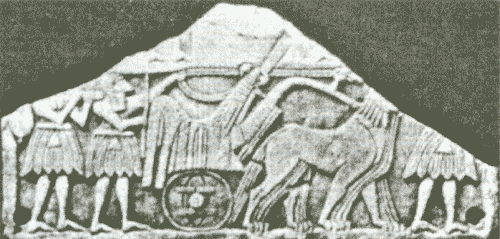
In 1956 Professor Samuel N. Kramer, one of the great Sumerologists
of our time, reviewed the literary legacy found beneath the mounds
of Sumer.
The table of contents of From the Tablets of Sumer is a
gem in itself, for each one of the twenty-five chapters described a
Sumerian "first," including the first schools, the first bicameral
congress, the first historian, the first pharmacopoeia, the first
"farmer's almanac," the first cosmogony and cosmology, the first
"Job," the first proverbs and sayings, the first literary debates,
the first "Noah," the first library catalogue; and Man's first
Heroic Age, his first law codes and social reforms, his first
medicine, agriculture, and search for world peace and harmony.
This is no exaggeration.
The first schools were established in Sumer as a direct outgrowth of
the invention and introduction of writing. The evidence (both
archaeological, such as actual school buildings, and written, such
as exercise tablets) indicates the existence of a formal system of
education by the beginning of the third millennium B.C.
There were
literally thousands of scribes in Sumer, ranging from junior scribes
to high scribes, royal scribes, temple scribes, and scribes who
assumed high state office. Some acted as teachers at the schools,
and we can still read their essays on the schools, their aims and
goals, their curriculum and teaching methods.
The schools taught not only language and writing but also the
sciences of the day - botany, zoology, geography, mathematics, and
theology. Literary works of the past were studied and copied, and
new ones were composed.
The schools were headed by the ummia ("expert professor"), and the
faculty invariably included not only a "man in charge of drawing"
and a "man in charge of Sumerian," but also a "man in charge of the
whip." Apparently, discipline was strict; one school alumnus
described on a clay tablet how he had been flogged for missing
school, for insufficient neatness, for loitering, for not keeping
silent, for misbehaving, and even for not having neat handwriting.
An epic poem dealing with the history of Erech concerns itself with
the rivalry between Erech and the city-state of Kish. The epic text
relates how the envoys of Kish proceeded to Erech, offering a
peaceful settlement of their dispute. But the ruler of Erech at the
time, Gilgamesh, preferred to fight rather than negotiate.
What is
interesting is that he had to put the matter to a vote in the
Assembly of the Elders, the local "Senate":
The lord Gilgamesh,
Before the elders of his city put the matter,
Seeks out the decision:
"Let us not submit to the house of Kish,
let us smite it with weapons."
The Assembly of the Elders was, however, for negotiations.
Undaunted, Gilgamesh took the matter to the younger people, the
Assembly of the Fighting Men, who voted for war. The significance of
the tale lies in its disclosure that a Sumerian ruler had to submit
the question of war or peace to the First Bicameral Congress, some
5,000 years ago.
The title of First Historian was bestowed by Kramer on Entemena,
king of Lagash, who recorded on clay cylinders his war with
neighboring Umma. While other texts were literary works or epic
poems whose themes were historical events, the inscriptions by
Entemena were straight prose, written solely as a factual record of
history.
Because the inscriptions of Assyria and Babylonia were deciphered
well before the Sumerian records, it was long believed that the
first code of laws was compiled and decreed by the Babylonian king
Hammurabi, circa 1900 B.C. But as Sumer's civilization was
uncovered, it became clear that the "firsts" for a system of laws,
for concepts of social order, and for the fair administration of
justice belonged to Sumer.
Well before Hammurabi, a Sumerian ruler of the city-state of
Eshnunna (northeast of Babylon) encoded laws that set maximum prices
for foodstuffs and for the rental of wagons and boats so that the
poor could not be oppressed. There were also laws dealing with
offenses against person and property, and regulations pertaining to
family matters and to master - servant relations.
Even earlier, a code was promulgated by Lipit-Ishtar, a ruler of
Isin. The thirty-eight laws that remain legible on the partly
preserved tablet (a copy of an original that was engraved on a stone
stela) deal with real estate, slaves and servants, marriage and
inheritance, the hiring of boats, the rental of oxen, and defaults
on taxes.
As was done by Hammurabi after him, Lipit-Ishtar explained
in the prologue to his code that he acted on the instructions of
"the great gods," who had ordered him "to bring well-being to the
Sumerians and the Akkadians."
Yet even Lipit-Ishtar was not the first Sumerian law encoder.
Fragments of clay tablets that have been found contain copies of
laws encoded by Urnammu, a ruler of Ur circa 2350 B.C. - more than
half a millennium before
Hammurabi.
The laws, enacted on the authority of the god Nannar,
were aimed at stopping and punishing "the grabbers-of the citizens'
oxen, sheep, and donkeys" so that "the orphan shall not fall prey to
the wealthy, the widow shall not fall prey to the powerful, the man
of one shekel shall not fall prey to a man of 60 shekels," Urnammu
also decreed "honest and unchangeable weights and measurements."
But the Sumerian legal system, and the enforcement of justice, go
back even farther in time.
By 2600 B.C. so much must already have happened in Sumer that the
ensi Urukagina found it necessary to institute reforms. A long
inscription by him has been called by scholars a precious record of
man's first social reform based on a sense of freedom, equality, and
justice - a "French Revolution" imposed by a king 4,400 years before
July 14, 1789.
The reform decree of Urukagina listed the evils of his time first,
then the reforms. The evils consisted primarily of the unfair use by
supervisors of their powers to take the best for themselves; the
abuse of official status; the extortion of high prices by
monopolistic groups.
All such injustices, and many more, were prohibited by the reform
decree. An official could no longer set his own price "for a good
donkey or a house." A "big man" could no longer coerce a common
citizen. The rights of the blind, poor, widowed, and orphaned were
restated. A divorced woman - nearly 5,000 years ago - was granted
the protection of the law.
How long had Sumerian civilization existed that it required a major
reform? Clearly, a long time, for Urukagina claimed that it was his
god Ningirsu who called upon him "to restore the decrees of former
days." The clear implication is that a return to even older systems
and earlier laws was called for.
The Sumerian laws were upheld by a court system in which the
proceedings and judgments as well as contracts were meticulously
recorded and preserved. The justices acted more like juries than
judges; a court was usually made up of three or four judges, one of
whom was a professional "royal judge" and the others drawn from a
panel of thirty-six men.
While the Babylonians made rules and regulations, the Sumerians were
concerned with justice, for they believed that the gods appointed
the kings primarily to assure justice in the land.
More than one parallel can be drawn here with the concepts of
justice and morality of the Old Testament. Even before the Hebrews
had kings, they were governed by judges; kings were judged not by
their conquests or wealth but by the extent to which they "did the
righteous thing." In the Jewish religion, the New Year marks a
ten-day period during which the deeds of men are weighed and
evaluated to determine their fate in the coming year.
It is probably
more than a coincidence that the Sumerians believed that a deity
named Nanshe annually judged Mankind in the same manner; after all,
the first Hebrew patriarch - Abraham - came from the Sumerian city
of Ur, the city of Ur-Nammu and his code.
The Sumerian concern with justice or its absence also found
expression in what Kramer called "the first 'Job.'" Matching
together fragments of clay tablets at the Istanbul Museum of
Antiquities, Kramer was able to read a good part of a Sumerian poem
which, like the biblical Book of Job, dealt with the complaint of a
righteous man who, instead of being blessed by the gods, was made to
suffer all manner of loss and disrespect. "My righteous word has
been turned into a lie," he cried out in anguish.
In its second part, the anonymous sufferer petitions his god in a
manner akin to some verses in the Hebrew Psalms:
My god, you who are my father, who .begot me - -lift up my face.... How long will you neglect me, leave me unprotected... leave me
without guidance?
Then follows a happy ending. "The righteous words, the pure words
uttered by him, his god accepted; ... his god withdrew his hand from
the evil pronouncement."
Preceding the biblical Book of Ecclesiastes by some two millennia,
Sumerian proverbs conveyed many of the same concepts and witticisms.
If we are doomed to die - let us spend; If we shall live long - let
us save.
When a poor man dies, do not try to revive him.
He who possesses much silver, may be happy; He who possesses much
barley, may be happy; But who has nothing at all, can sleep!
Man: For his pleasure: Marriage; On his thinking it over: Divorce.
It is not the heart which leads to enmity; it is the tongue which
leads to enmity.
In a city without watchdogs, the fox is the overseer.
The material and spiritual achievements of the Sumerian civilization
were also accompanied by an extensive development of the performing
arts.
A team of scholars from the University of California at
Berkeley made news in March 1974 when they announced that they had
deciphered the world's oldest song.
What professors Richard L.
Crocker, Anne D. Kilmer, and Robert R. Brown achieved was to read
and actually play the musical notes written on a cuneiform tablet
from circa 1800 B.C., found at Ugarit on the Mediterranean coast
(now in Syria).
"We always knew," the Berkeley team explained, "that (here was music
in the earlier Assyrio-Babylonian civilization, but until this
deciphering we did not know that it had the same heptatonic-diatonic
scale that is characteristic of contemporary Western music, and of
Greek music of the first millennium B.C."
Until now it was thought
that Western music originated in Greece; now it has been established
that our music - as so much else of Western civilization -
originated in Mesopotamia.
This should not be surprising, for the
Greek scholar Philo had already stilted that the Mesopotamians were
known to "seek worldwide harmony and unison through the musical
tones."
There can be no doubt that music and song must also be claimed as a
Sumerian "first." Indeed, Professor Crocker could play the ancient
tune only by constructing a lyre like those which had been found in
the ruins of Ur.
Texts from the second millennium B.C. indicate the
existence of musical "key numbers" and a coherent musical theory;
and Professor Kilmer herself wrote earlier (The Strings of Musical
Instruments: Their Names, Numbers and Significance) that many
Sumerian hymnal texts had "what appear to be musical notations in
the margins." "The Sumerians and their successors had a full musical
life," she concluded.
No wonder, then, that we find a great variety
of musical instruments - as well as of singers and dancers
performing - depicted on cylinder seals and clay tablets.
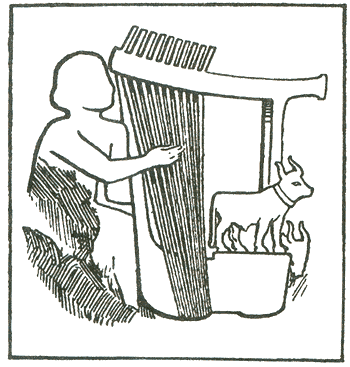
Like so many other Sumerian achievements, music and song also
originated in the temples. But, beginning in the service of the
gods, these performing arts soon were also prevalent outside the
temples.
Employing the favorite
Sumerian play on words, a popular saying commented on the fees
charged by singers:
"A singer whose voice is not sweet is a 'poor'
singer indeed."
Many Sumerian love songs have been found; they were undoubtedly sung
to musical accompaniment. Most touching, however, is a lullaby that
a mother composed and sang to her sick child:
Come sleep, come sleep, come to my son.
Hurry sleep to my son;
Put to sleep his restless eyes. ...
You are in pain, my son;
I am troubled, I am struck dumb,
I gaze up to the stars.
The new moon shines down on your face;
Your shadow will shed tears for you.
Lie, lie in your sleep....
May the goddess of growth be your ally;
May you have an eloquent
guardian in heaven;
May you achieve a reign of happy days....
May
a wife be your support;
May a son be your future lot.
What is striking about such music and songs is not only the
conclusion that Sumer was the source of Western music in structure
and harmonic composition.
No less significant is the fact that as we
hear the music and read the poems, they do not sound strange or
alien at all, even in their depth of feeling and their sentiments.
Indeed, as we contemplate the great Sumerian civilization, we find
that not only are our morals and our sense of justice, our laws and
architecture and arts and technology rooted in Sumer, but the
Sumerian institutions are so familiar, so close. At heart, it would
seem, we are all Sumerians.
After excavating at Lagash, the archaeologist's spade uncovered
Nipper, the onetime religious center of Sumer and Akkad. Of the
30,000 texts found there, many remain unstudied to this day.
At Shuruppak, schoolhouses dating to the third millennium B.C. were
found. At Ur, scholars found magnificent vases, jewelry, weapons,
chariots, helmets made of gold, silver, copper, and bronze, the
remains of a weaving factory, court records - and a towering
ziggurat whose ruins still dominate the landscape.
At Eshnunna and
Adab the archaeologists found temples and artful statues from pre-Sargonic
times. Umma produced inscriptions speaking of early empires. At Kish
monumental buildings and a ziggurat from at least 3000 B.C. were
unearthed.
Uruk (Erech) took the archaeologists back into the fourth millennium
B.C. There they found the first colored pottery baked in a kiln, and
evidence of the first use of a potter's wheel. A pavement of
limestone blocks is the oldest stone construction found to date. At
Uruk the archaeologists also found the first ziggurat - a vast
man-made mound, on top of which stood a white temple and a red
temple. The world's first inscribed texts were also found there, as
well as the first cylinder seals.
Of the latter, Jack Finegan (Light
from the Ancient Past) said,
"The excellence of the seals upon their
first appearance in the Uruk period is amazing."
Other sites of the Uruk period bear evidence of the emergence of the Metal Age.
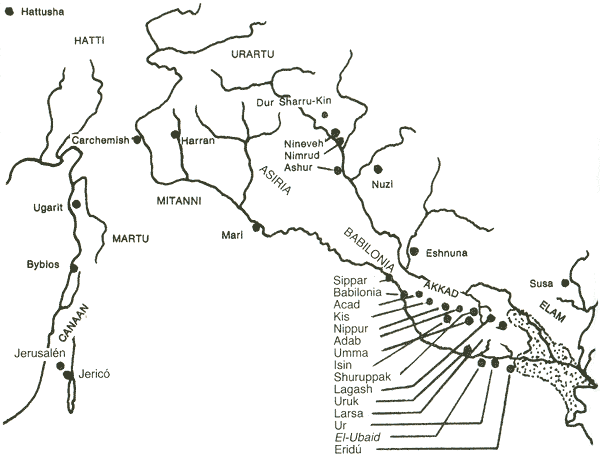
In 1919, H. R. Hall came upon ancient ruins at a village now called
El-Ubaid.
The site gave its name to what scholars now consider the
first phase of the great Sumerian civilization. Sumerian cities of
that period - ranging from northern Mesopotamia to the southern
Zagros foothills - produced the first use of clay bricks, plastered
walls, mosaic decorations, cemeteries with brick-lined graves,
painted and decorated ceramic wares with geometric designs, copper
mirrors, beads of imported turquoise, paint for eyelids,
copper-headed "tomahawks," cloth, houses, and, above all, monumental
temple buildings.
Farther south, the archaeologists found Eridu - the first Sumerian
city, according to ancient texts. As the excavators dug deeper, they
came upon a temple dedicated to Enki, Sumer's God of Knowledge,
which appeared to have been built and rebuilt many times over.
The
strata clearly led the scholars back to the beginnings of Sumerian
civilization: 2500 B.C., 2800 B.C., 3000 B.C., 3500 B.C.
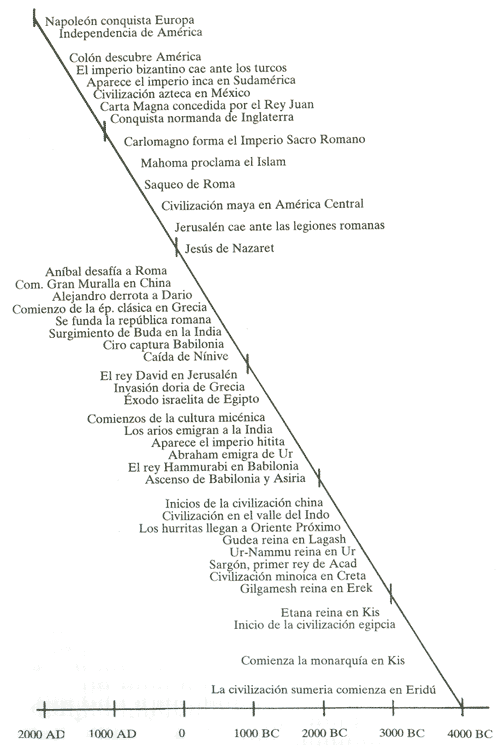
Then the spades came upon the foundations of the first temple
dedicated to Enki.
Below that, there was virgin
soil - nothing had been built before. The time was circa 3800 B.C.
That is when civilization began.
It was not only the first civilization in the true sense of the
term. It was a most extensive civilization, all-encompassing, in
many ways more advanced than the other ancient cultures that had
followed it. It was undoubtedly the civilization on which our own is
based.
Having begun to use stones as tools some 2,000,000 years earlier,
Man achieved this unprecedented civilization in Sumer circa 3800
B.C. And the perplexing fact about this is that to this very day the
scholars have no inkling who the Sumerians were, where they came
from, and how and why their civilization appeared.
For its appearance was sudden, unexpected, and out of nowhere.
H. Frankfort (Tell Uqair) called it "astonishing." Pierre Amiet
(Elam) termed it "extraordinary." A. Parrot (Sumer) described it as
"a flame which blazed up so suddenly." Leo Oppenheim (Ancient
Mesopotamia) stressed "the astonishingly short period" within which
this civilization had arisen.
Joseph Campbell (The Masks of God)
summed it up in this way:
"With stunning abruptness... there
appears in this little Sumerian mud garden... the whole cultural
syndrome that has since constituted the germinal unit of all the
high civilizations of the world."
Return to Contents
|

















